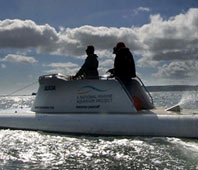TV Program Description
Original PBS Broadcast Date: December 26, 2006
Engineering ingenuity and one man's astounding determination
are at the center of this program, which follows American
entrepreneur Peter Robbins as he embarks on a 10-year odyssey
to create his own million-dollar underwater vessel from
scratch and explore the sunken wrecks of German U-boats (see
A Lifelong Dream).
The film follows the submarine's progress from design to
manufacturing, a daunting endeavor without the resources of a
big shipyard or backing of the military, and one that requires
some truly innovative solutions, since parts must be scavenged
or even bought off-the-shelf at business supply stores. The
show chronicles the obstacles and successes, the sheer
imagination and motivation of Robbins and his small team in
bold pursuit of building his underwater dream machine.
Throughout his life, Peter Robbins has cultivated a passion
for submarines reminiscent of the fabled Captain Nemo of Jules
Verne's 20,000 Leagues Under the Sea. (See an
excerpt from this
classic novel.) As an engineer, he is fascinated by the
precision of Germany's U-boat technology; as an entrepreneur,
he is intrigued by the prospect of underwater tourism. The
documentary immerses viewers in Robbins's remarkable story, in
which he risks everything to create his pet project, the
Alicia—a one-of-a-kind, privately built, six-person sub with
a panoramic view—and then tests his invention with a
dive into the past to uncover a piece of history.
"Underwater Dream Machine" delves into the fascinating details
surrounding Alicia's genesis. Assembled at a cost of
$1.5 million, Alicia's design and construction are
monumentally complicated undertakings. NOVA cameras accompany
the team whose job it is to bring to life Robbins's vision,
spotlighting the inventive engineering and creative
problem-solving as the project slowly takes shape in a small
warehouse.
Viewers will see how limited funds and the absence of a
submarine superstore for parts push the team members to become
creative builders. The design crew shops for seats at Office
World, takes the engine from a truck and modifies it, and
repurposes 60 forklift batteries to power the sub underwater.
Unique to the project are several enormous acrylic domes,
specially designed bubble windows to provide passengers with a
180-degree view of the ocean world. The single most costly
components to produce, they are crucial to the submarine's
viability as a tourism venture but extremely difficult to
perfect. After several marred attempts, Robbins begins to fret
over whether these can ever be manufactured without flaws.
The sub's other functional features include a manganese steel
hull measuring over 16 feet long, a soda-lime gas scrubbing
system that maintains oxygen levels inside the sub, and the
sliding belts employed to shift the weight of batteries during
dives. The end result is an 18-ton, two-engine vehicle devised
to dive to 1,000 feet and withstand pressure of twice that
encountered at maximum depth.
"Underwater Dream Machine" also examines the mounting
emotional pressure on Robbins as invoices pile up and
schedules are pushed back. It also looks at the motivations
driving one man to risk bankruptcy time and again for a
journey to the ocean floor.
On its inaugural mission, Alicia steams out of
England's Plymouth Harbor on an uncertain dive to test whether
the sub is operable—an event that could have historic
implications. Thirty-nine German U-boats litter the seabed of
the English Channel. These were Hitler's most feared weapons,
and the Alicia gives Robbins the chance to try and find
them. He tells NOVA how he is captivated "by the technology,
the stories of the people who worked in them, fought in them,
and died in them."
One such gripping tale is that of U-boat veteran Rudi Wieser,
who was one of the few to survive his submarine's sinking and
now shares with NOVA a vivid first-hand account of his escape
to the surface. Robbins invites the 81-year-old to join him on
the
Alicia's maiden voyage—an expedition to find
Wieser's sub, the U-1195.

Program Transcript
Program Credits

